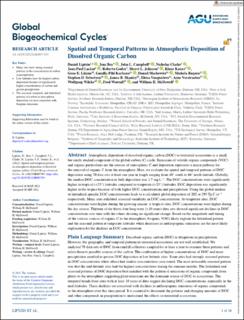| dc.contributor.author | Liptzin, Daniel | |
| dc.contributor.author | Boy, Jens | |
| dc.contributor.author | Campbell, John L. | |
| dc.contributor.author | Clarke, Nicholas | |
| dc.contributor.author | Laclau, Jean-Paul | |
| dc.contributor.author | Godoy, Roberto | |
| dc.contributor.author | Johnson, Sherri L. | |
| dc.contributor.author | Kaiser, Klaus | |
| dc.contributor.author | Likens, Gene E. | |
| dc.contributor.author | Karlsson, Gunilla Pihl | |
| dc.contributor.author | Markewitz, Daniel | |
| dc.contributor.author | Rogora, Michela | |
| dc.contributor.author | Sebestyen, Stephen D. | |
| dc.contributor.author | Shanley, James B. | |
| dc.contributor.author | Vanguelova, Elena | |
| dc.contributor.author | Verstraeten, Arne | |
| dc.contributor.author | Wilcke, Wolfgang | |
| dc.contributor.author | Worrall, Fred | |
| dc.contributor.author | McDowell, William H. | |
| dc.date.accessioned | 2022-10-31T13:39:41Z | |
| dc.date.available | 2022-10-31T13:39:41Z | |
| dc.date.created | 2022-10-12T09:32:56Z | |
| dc.date.issued | 2022-10-11 | |
| dc.identifier.citation | Global Biogeochemical Cycles. 2022, 36 (10), . | en_US |
| dc.identifier.issn | 0886-6236 | |
| dc.identifier.uri | https://hdl.handle.net/11250/3029168 | |
| dc.description.abstract | Atmospheric deposition of dissolved organic carbon (DOC) to terrestrial ecosystems is a small, but rarely studied component of the global carbon (C) cycle. Emissions of volatile organic compounds (VOC) and organic particulates are the sources of atmospheric C and deposition represents a major pathway for the removal of organic C from the atmosphere. Here, we evaluate the spatial and temporal patterns of DOC deposition using 70 data sets at least one year in length ranging from 40° south to 66° north latitude. Globally, the median DOC concentration in bulk deposition was 1.7 mg L−1. The DOC concentrations were significantly higher in tropical (<25°) latitudes compared to temperate (>25°) latitudes. DOC deposition was significantly higher in the tropics because of both higher DOC concentrations and precipitation. Using the global median or latitudinal specific DOC concentrations leads to a calculated global deposition of 202 or 295 Tg C yr−1 respectively. Many sites exhibited seasonal variability in DOC concentration. At temperate sites, DOC concentrations were higher during the growing season; at tropical sites, DOC concentrations were higher during the dry season. Thirteen of the thirty-four long-term (>10 years) data sets showed significant declines in DOC concentration over time with the others showing no significant change. Based on the magnitude and timing of the various sources of organic C to the atmosphere, biogenic VOCs likely explain the latitudinal pattern and the seasonal pattern at temperate latitudes while decreases in anthropogenic emissions are the most likely explanation for the declines in DOC concentration. | en_US |
| dc.language.iso | eng | en_US |
| dc.publisher | American Geophysical Union | en_US |
| dc.rights | Navngivelse-Ikkekommersiell 4.0 Internasjonal | * |
| dc.rights.uri | http://creativecommons.org/licenses/by-nc/4.0/deed.no | * |
| dc.title | Spatial and Temporal Patterns in Atmospheric Deposition of Dissolved Organic Carbon | en_US |
| dc.title.alternative | Spatial and Temporal Patterns in Atmospheric Deposition of Dissolved Organic Carbon | en_US |
| dc.type | Peer reviewed | en_US |
| dc.type | Journal article | en_US |
| dc.description.version | publishedVersion | en_US |
| dc.rights.holder | © 2022 The Authors | en_US |
| dc.source.pagenumber | 16 | en_US |
| dc.source.volume | 36 | en_US |
| dc.source.journal | Global Biogeochemical Cycles | en_US |
| dc.source.issue | 10 | en_US |
| dc.identifier.doi | 10.1029/2022GB007393 | |
| dc.identifier.cristin | 2060717 | |
| dc.source.articlenumber | e2022GB007393 | en_US |
| cristin.ispublished | true | |
| cristin.fulltext | original | |
| cristin.fulltext | original | |
| cristin.qualitycode | 2 | |

